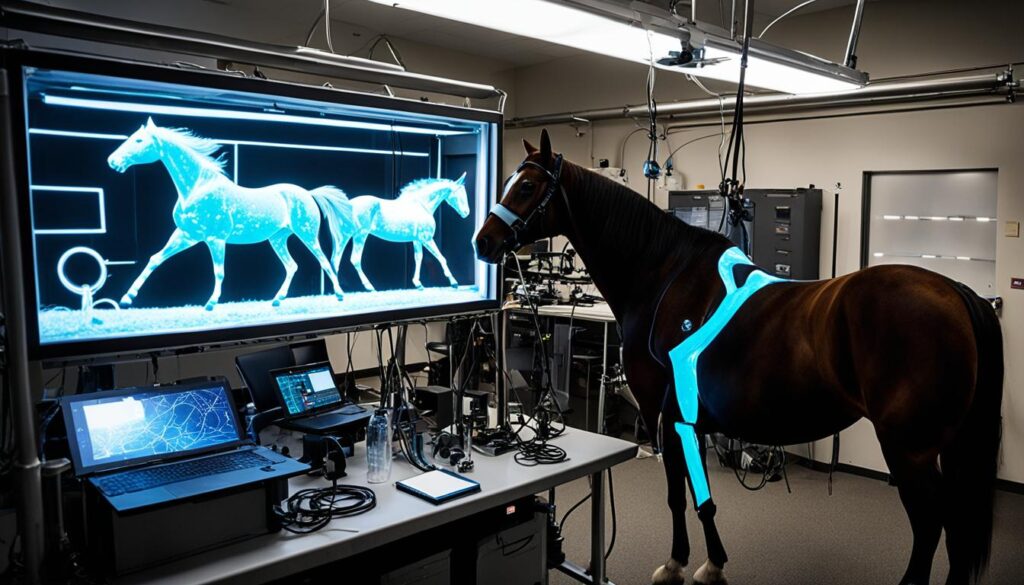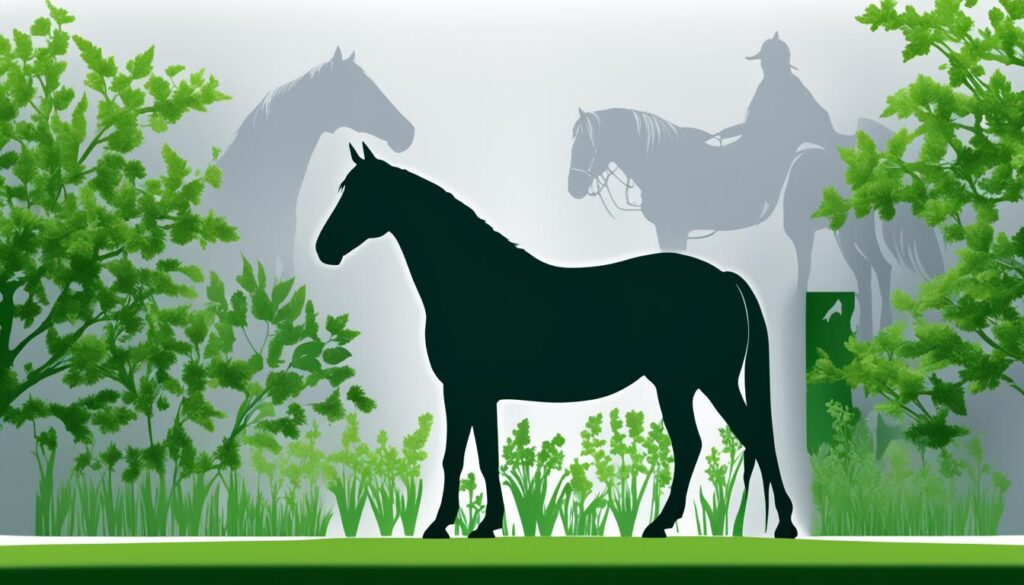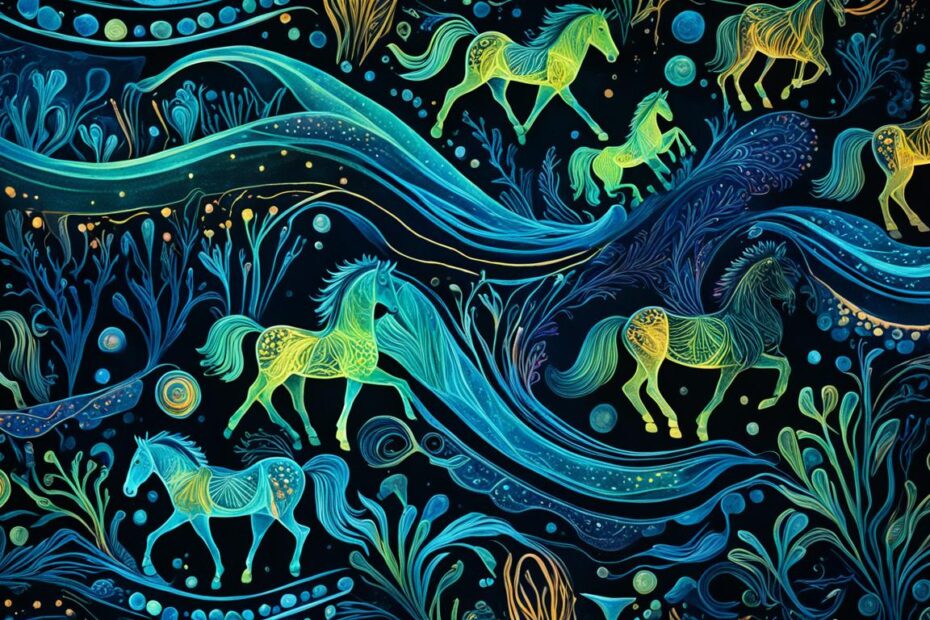In the captivating world of equine behavior, a hidden language of light has long remained a mystery. However, recent advancements in the field of animal biophotonics have shed new light on the intricate communication systems that horses employ.
This article delves into the fascinating realm of equine bioluminescent signaling, uncovering the hidden codes and patterns that horses use to convey messages and interact with one another.
Through groundbreaking research, we will explore the various aspects of equine bioacoustics, where horses utilize bioluminescent waveforms to express their emotions and social dynamics. We will also examine the role of biochemiluminescent encoding, revealing how horses harness the power of light-based semiotics to create a unique and enigmatic language that is still largely unexplored.
By understanding the ethological implications of biophotonic communication, we can gain deeper insights into the social structures and hierarchies that govern the equine world.
Furthermore, we will explore the pioneering methodologies used by researchers to unravel the mysteries of equine communication, drawing upon multidisciplinary approaches that combine the fields of biology, physics, and semiotics.
Key Takeaways
- Horses use bioluminescent patterns to communicate and interact with one another.
- Equine bioacoustics and biophotonics play a crucial role in the expression of emotions and social dynamics.
- Biochemiluminescent encoding allows horses to create a unique, light-based semiotic system.
- Ethological research provides insights into the social structures and hierarchies of the equine world.
- Multidisciplinary approaches are key to unraveling the mysteries of equine communication.
Unveiling Nature’s Enigmatic Light Codes
Delving into the captivating realm of equine bioacoustics, we uncover a frontier of discovery where the mysteries of bioluminescence converge with the intricate communication patterns of horses.
This intriguing intersection sheds light on the hidden language of light-based signaling, revealing the cryptic codes that shape the social dynamics of these majestic creatures.
Equine Bioacoustics: A Frontier of Discovery
Researchers in the field of equine bioacoustics have uncovered a fascinating dimension of horse communication, one that extends beyond the realm of vocalizations and physical cues.
By exploring the subtle interplay of photic waveforms and biochemiluminescent encoding, scientists are unearthing the profound significance of bioluminescence in the equine world.
Bioluminescence: Nature’s Cryptic Language
The captivating glow of bioluminescence has long been observed in various species, but its role in equine communication has remained largely enigmatic.
Bioluminescence biosemiotics, the study of light-based signaling systems, is shedding new light on the intricate ways in which horses harness the power of animal biophotonics to convey subtle messages and navigate their social landscapes.
| Bioluminescent Patterns | Potential Signaling Functions |
|---|---|
| Pulsing Flashes | Territorial Demarcation, Mating Displays |
| Steady Glowing Patterns | Herd Cohesion, Identification Cues |
| Synchronous Illumination | Coordinated Group Behavior, Predator Deterrence |
By deciphering the complex tapestry of bioluminescent patterns and their associated signaling functions, researchers are unveiling the enigmatic light codes that shape the social dynamics of the equine world.
This groundbreaking exploration into the intersection of equine bioacoustics and bioluminescence promises to redefine our understanding of how these magnificent animals communicate and interact with their environment.
Bioluminescent Waveforms: Decoding Equine Expression
Horses possess a remarkable ability to communicate through intricate patterns of bioluminescent signaling. By studying the complex photic waveforms generated by these majestic creatures, researchers have uncovered a hidden language that reveals a wealth of information about their social dynamics, emotional states, and even territorial boundaries.
The key to deciphering this bioluminescent code lies in the analysis of the distinct biochemiluminescent encoding that horses employ. These light-based displays, which range from subtle flickers to captivating choreographed sequences, convey a diverse array of messages, from dominance hierarchies to mating rituals.
Through the lens of bioluminescence biosemiotics, scientists are unraveling the mysteries of equine expression, gaining unprecedented insights into the innermost workings of these enigmatic animals.
By understanding the nuanced meanings behind the horses’ photic waveforms, researchers are opening new frontiers in the field of equine communication, unlocking a deeper understanding of these majestic creatures.
| Bioluminescent Waveform | Equine Expression |
|---|---|
| Rapid flashing | Alarm or danger |
| Slow pulsing | Calm or relaxed state |
| Synchronized patterns | Social bonding or courtship |
| Directional beams | Territorial marking or threat |
The study of bioluminescent waveforms has opened a new frontier in the realm of equine communication, providing researchers with a powerful tool to decipher the hidden language of these majestic animals.
By unlocking the secrets of these light-based signals, we can gain a deeper understanding of the rich tapestry of equine expression, ultimately fostering a more harmonious and respectful relationship between humans and horses.
Investigating Bioluminescent Patterns in Horse Communication
Horses have long been known for their remarkable ability to communicate, but recent advancements in the field of bioluminescence have revealed a fascinating new dimension to their interaction.
Researchers have discovered that these majestic animals possess the capacity to produce and modulate complex light-based signals, which they employ to convey a wide range of messages and social cues.
Biochemiluminescent Encoding: Horses’ Light-Based Semiotics
By examining the biochemical processes underlying these bioluminescent displays, scientists have gained a deeper understanding of the sophisticated communication systems employed by horses.
Through the intricate interplay of various biomolecules and enzymes, these animals are able to encode and transmit a diverse array of information, ranging from emotional states and social hierarchies to mating signals and territorial claims.
The study of bioluminescence biosemiotics, or the semiotic principles governing the interpretation of these light-based signals, has further illuminated the nuanced and multifaceted nature of equine communication. Horses have been observed to utilize distinct bioluminescent patterns and modulations to convey specific messages, demonstrating a remarkable level of communicative complexity.
| Bioluminescent Signal | Potential Meaning |
|---|---|
| Steady, pulsing glow | Calm, relaxed state |
| Flickering, erratic pattern | Heightened emotional state (e.g., fear, excitement) |
| Concentrated, directed beam | Aggressive or dominance display |
| Synchronous, coordinated flashing | Social bonding or courtship behavior |
By deciphering the intricate biochemical and semiotic underpinnings of equine bioluminescent communication, researchers are poised to unveil new insights into the social dynamics, cognitive abilities, and overall behavioral repertoire of these remarkable animals.
Equine Photic Signaling: Insights into Social Dynamics
Horses, magnificent creatures that have captured the imagination of humans for centuries, possess a remarkable ability to communicate through the language of light.
Recent research has unveiled the intriguing world of equine photic signaling, where bioluminescent patterns play a crucial role in shaping the social dynamics of horse communities.
Ethological Implications of Biophotonic Communication
By examining the ethological implications of this biophotonic communication, we gain valuable insights into the complex social structures and behavioral patterns that govern the equine world.
Horses utilize these luminescent displays to convey a range of social cues, including dominance hierarchies, courtship behavior, and group cohesion.
Through the study of equine photic signaling, researchers have uncovered the fascinating ways in which horses leverage the power of light to navigate their social landscape. This bioluminescent language allows these majestic animals to establish and maintain their positions within the herd, forge connections, and coordinate their collective movements.
The ethological implications of this biophotonic communication are far-reaching, as they shed light on the intricate social dynamics that shape the lives of horses.
By deciphering the nuances of these light-based signals, we can better understand the complex cognitive and emotional processes that underlie equine behavior, ultimately leading to a more profound appreciation of these remarkable animals.
- Equine photic signaling reveals insights into social hierarchies and group dynamics
- Biophotonic communication helps horses coordinate courtship, breeding, and herd cohesion
- Studying the ethological implications of equine light-based signals advances our understanding of equine cognition and behavior
As we continue to unravel the mysteries of equine photic signaling, the field of equine communication research continues to expand, providing us with a deeper understanding of the intricate social lives of horses and the captivating ways in which they interact with their environment.
Animal Biophotonics: Redefining Interspecies Interaction
The captivating realm of animal biophotonics has opened new frontiers in our understanding of interspecies communication. Researchers have discovered that the intriguing bioluminescent patterns observed in horses are not unique to this majestic species, but rather a widespread phenomenon across the animal kingdom.
By exploring the ways in which diverse species utilize light-based signaling to interact and convey information, we gain a more holistic view of the complex web of relationships that exists in the natural world.
This field of study not only sheds light on the hidden mechanisms of interspecies communication but also paves the way for groundbreaking insights and discoveries in the study of animal behavior.
From the glowing courtship displays of fireflies to the intricate bioluminescent patterns of deep-sea creatures, the world of animal biophotonics is a captivating and largely untapped domain. As we delve deeper into this fascinating field, we uncover a new realm of understanding, one that redefines our perception of how different species interact and coexist in the natural environment.
| Species | Bioluminescent Traits | Ecological Function |
|---|---|---|
| Fireflies | Flashing light patterns during courtship | Mate attraction and signaling |
| Bioluminescent plankton | Glowing in the ocean at night | Deterring predators and attracting prey |
| Anglerfish | Luminous lure to attract prey | Hunting and feeding |
As we continue to unravel the mysteries of animal biophotonics, we open up new avenues for exploring the intricate tapestry of interspecies interactions.
This field of study not only captivates our imagination but also holds the potential to redefine our understanding of the natural world and the vital connections that bind all living beings.
Pioneering Methodologies in Equine Communication Research
The field of equine communication research is witnessing a remarkable surge in innovative methodologies as researchers from diverse disciplines come together to unravel the mysteries of nature. This multidisciplinary approach is yielding groundbreaking insights into the complex bioluminescent patterns and signals horses use to communicate.
Multidisciplinary Approaches to Unraveling Nature’s Mysteries
Researchers in the field of equine communication research are embracing a holistic, collaborative approach, drawing on expertise from fields such as biology, physics, ethology, and computer science.
By integrating these multidisciplinary perspectives, they are developing novel techniques and technologies to capture and analyze the intricate light-based signals produced by horses.
- Cutting-edge imaging and spectroscopy methods are enabling scientists to visualize and study the bioluminescent patterns in unprecedented detail.
- Advances in bioacoustic analysis are revealing the complex interplay between equine vocalizations and biophotonic communication.
- Computational modeling and machine learning algorithms are helping researchers decode the underlying “language” of equine light-based signaling.
This cross-pollination of ideas and methodologies is driving the field of equine communication research forward, unlocking new dimensions of understanding about the natural world and the intricate ways in which horses communicate.
| Discipline | Contribution to Equine Communication Research |
|---|---|
| Biology | Investigating the biochemical and physiological mechanisms behind equine bioluminescence |
| Physics | Analyzing the physical properties and dynamics of biophotonic signals |
| Ethology | Studying the behavioral and social contexts in which equine light-based communication occurs |
| Computer Science | Developing advanced data analysis and modeling tools to decipher equine communication patterns |
By embracing this multidisciplinary approach, researchers are pushing the boundaries of our understanding of equine communication, unlocking the secrets of nature’s enigmatic light codes and paving the way for groundbreaking discoveries.

Bioluminescence Biosemiotics: Expanding Frontiers
In the captivating world of equine communication, a new frontier has emerged – the field of bioluminescence biosemiotics. This intersection of biophotonics, biochemistry, and ethology is shedding light on the hidden meanings behind the luminescent signals observed in horses and other animals.
Biosemiotics, the study of sign-based interactions in living systems, provides a powerful framework for deciphering the rich tapestry of signaling systems that govern the natural world.
By combining this discipline with the principles of bioluminescence, researchers are uncovering a vast and intricate network of communication that extends far beyond the limits of human perception.
The key to unlocking these mysteries lies in understanding the intricate dance of light and biochemistry that underlies bioluminescent phenomena. From the subtle flashes of fireflies to the mesmerizing displays of deep-sea creatures, these natural light shows are the product of complex chemical reactions driven by specialized enzymes and substrates.
When applied to the study of equine behavior, bioluminescence biosemiotics holds the potential to reveal the hidden language of these majestic animals. By deciphering the nuanced patterns and rhythms of their biophotonic signals, researchers can gain unprecedented insights into the social dynamics, emotional states, and even cognitive processes that shape the lives of horses.
As this field continues to evolve, the possibilities for expanding our understanding of interspecies communication are truly limitless. By bridging the gap between the sciences of biology, chemistry, and ethology, bioluminescence biosemiotics promises to open new windows into the natural world, shedding light on the hidden realms of animal expression and cognition.
| Key Concepts | Applications |
|---|---|
| Bioluminescence | Equine communication |
| Biosemiotics | Interspecies interaction |
| Biochemistry | Ethological research |
| Biophotonics | Decoding natural signals |
Equine Bioluminescent Patterns: Unlocking Hidden Realms
The intriguing world of equine bioluminescent patterns holds the key to unraveling the complex communication and social dynamics of these majestic creatures.
Researchers are collaborating closely with experienced equestrians, blending scientific knowledge and traditional equestrian wisdom to deepen our understanding of the remarkable light-based signals that horses employ.
Bridging the Gap Between Science and Equestrian Wisdom
By bridging the gap between scientific inquiry and the time-honored insights of equestrian practitioners, we can unlock the hidden realms of equine communication. Equestrian wisdom, honed through generations of close observation and interaction with horses, provides invaluable context and nuance to the scientific data.
Equine bioluminescent patterns offer a captivating window into the social and behavioral patterns that govern the equine world. Decoding these light-based signals can reveal the intricate ways in which horses convey emotion, establish hierarchy, and navigate their complex social structures.
| Bioluminescent Patterns | Equestrian Insights | Scientific Findings |
|---|---|---|
| Flank Flashing | Signaling Dominance | Hormone-Driven Displays |
| Withers Glowing | Indicating Submission | Neurotransmitter-Mediated Responses |
| Neck Illumination | Conveying Affection | Pheromone-Based Communication |
By blending these complementary perspectives, researchers and equestrians are uncovering the true significance of equine bioluminescent patterns, shedding light on the hidden realms of equine communication and behavior.
Ethical Considerations in Equine Communication Studies
As the field of equine communication studies continues to evolve, researchers must navigate a complex landscape of ethical considerations. The pursuit of scientific knowledge must be balanced with the welfare and well-being of the horses involved in these studies, particularly when exploring the intriguing realm of bioluminescent patterns.
Researchers in the field of equine communication studies are acutely aware of the need to uphold the highest ethical standards.
They understand that their investigations into the nuanced language of horses hold the potential to unlock groundbreaking insights, but must be carried out in a manner that respects the horses’ autonomy and minimizes any potential distress or harm.
A key ethical consideration is the informed consent of the horses’ owners or caretakers. Researchers must ensure that all participants in these studies are fully aware of the procedures and potential risks, and have voluntarily agreed to be part of the research.
This level of transparency and collaboration is crucial in building trust and fostering a mutually beneficial relationship between the scientific community and the equestrian world.
Additionally, researchers must be mindful of the impact their work may have on the horses themselves. Careful monitoring of the horses’ physical and emotional well-being throughout the study is essential, with immediate intervention and adjustments made if any signs of distress are observed. The scientific pursuit must always be tempered by a deep respect for the horses and their inherent welfare.
By upholding these ethical principles, the scientific community can ensure that their investigations into equine communication are conducted in a responsible and respectful manner. This approach not only safeguards the well-being of the horses but also lays the foundation for groundbreaking discoveries that benefit both the equine and human realms, ultimately strengthening the bond between these two species.

| Ethical Principle | Application in Equine Communication Studies |
|---|---|
| Informed Consent | Ensure voluntary participation of horse owners and caretakers with full disclosure of study procedures and potential risks. |
| Animal Welfare | Prioritize the physical and emotional well-being of horses throughout the research process, with immediate intervention if distress is observed. |
| Transparency and Collaboration | Foster open communication and cooperation between researchers and the equestrian community to build trust and mutual understanding. |
| Minimizing Harm | Design studies that minimize any potential negative impact on the horses, while still advancing scientific knowledge. |
Future Directions: Advancing Bioluminescent Equine Research
As our understanding of equine communication through light-based signaling continues to evolve, the future of bioluminescent equine research is brimming with exciting possibilities. Researchers are eager to uncover new insights that can inform our broader understanding of the natural world and redefine our relationship with these remarkable animals.
One promising avenue for future exploration is the development of innovative technologies for capturing and analyzing bioluminescent patterns. Advanced imaging techniques and data-driven analytics could provide unprecedented insights into the complex language of light-based equine communication, revealing hidden layers of social dynamics and behavioral cues.
Forging interdisciplinary collaborations that bridge the gap between science and traditional equestrian knowledge is another key area of focus. By integrating the expertise of researchers, veterinarians, and experienced horse handlers, researchers can gain a more holistic understanding of the role of bioluminescence in equine well-being and overall health.
Moreover, the future of bioluminescent equine research holds the potential to unlock groundbreaking discoveries that can inform our broader understanding of the natural world.
As we continue to explore the intricate connections between light, communication, and the equine species, we may uncover insights that redefine our relationship with these majestic creatures and the ecosystems they inhabit.
The path forward is filled with boundless potential, and the scientific community is poised to embark on an exciting journey of future directions in the realm of bioluminescent equine research.
Conclusion
As we conclude our investigation into the fascinating world of bioluminescent patterns in horse communication, we are left with a profound sense of wonder and admiration for the intricate language of light that these remarkable creatures employ.
Through groundbreaking research and collaborative efforts, we have unveiled the complex biochemical processes and ethological implications underlying their photic signaling, challenging our preconceptions and expanding the boundaries of our knowledge.
From the enigmatic biochemiluminescent encoding that horses utilize to convey a wide range of social cues to the insights we’ve gained into their biophotonic communication, this journey has been a testament to the incredible capabilities of these animals.
As we look to the future, we are filled with anticipation, eager to see how the continued study of equine bioluminescence will shape our understanding of the natural world and our relationship with these extraordinary creatures.
The conclusions drawn from our investigation into investigating bioluminescent patterns in horse communication have profound implications, not only for our scientific understanding but also for the way we perceive and interact with the equine species.
By unlocking the hidden realms of their conclusion, we are poised to redefine the boundaries of interspecies interaction and forge deeper connections with the natural world around us.
FAQ
What is the role of bioluminescent patterns in horse communication?
Horses use bioluminescent patterns to convey a wide range of messages and social cues, including information about their social status, emotional states, territorial boundaries, and mating rituals.
By analyzing the complex photic waveforms generated by horses, researchers are able to decipher the hidden meanings behind these bioluminescent displays, providing invaluable insights into the rich tapestry of equine communication.
How do researchers study equine bioacoustics and biophotonics?
Researchers from diverse fields, including biology, physics, and ethology, are collaborating to develop innovative techniques and technologies for capturing and analyzing the complex light-based signals produced by horses.
By embracing a holistic, interdisciplinary approach, these pioneering scientists are unlocking the secrets of equine communication and expanding our understanding of the natural world.
What is the significance of biochemiluminescent encoding in equine communication?
Horses possess the ability to produce and modulate complex light-based signals through biochemical processes.
By examining the biochemical encoding and semiotic principles that govern these bioluminescent displays, researchers are gaining a more comprehensive understanding of the sophisticated communication systems employed by these remarkable animals.
How do ethological implications inform our understanding of equine photic signaling?
Researchers have discovered that horses use bioluminescent patterns to convey a range of social cues, including dominance hierarchies, courtship behavior, and group cohesion. By examining the ethological implications of this biophotonic communication, we gain valuable insights into the complex social structures and behavioral patterns that govern the equine world.
What is the role of bioluminescence biosemiotics in equine communication research?
Biosemiotics, the study of sign-based interactions in living systems, provides a powerful framework for deciphering the hidden meanings behind the bioluminescent patterns observed in horses and other animals.
By combining the principles of biophotonics, biochemistry, and ethology, researchers are uncovering the rich tapestry of signaling systems that govern the natural world, paving the way for groundbreaking discoveries in the realm of interspecies communication.
How are researchers bridging the gap between science and equestrian wisdom in the study of equine bioluminescent patterns?
Researchers are working closely with experienced equestrians, combining scientific knowledge with traditional equestrian wisdom, to deepen our understanding of the complex social dynamics and behavioral patterns that govern the equine world.
By bridging the gap between these two domains, we can uncover the true significance of bioluminescent patterns in horse communication and unlock the full potential of these remarkable creatures.

